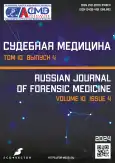Online tool for finite element analysis of postmortem convective heat transfer of the head
- Authors: Nedugiv V.G.1, Nedugov G.V.2
-
Affiliations:
- Samara National Research University
- Samara State Medical University
- Issue: Vol 10, No 4 (2024)
- Pages: 555-565
- Section: Technical reports
- URL: https://journal-vniispk.ru/2411-8729/article/view/288324
- DOI: https://doi.org/10.17816/fm16175
- ID: 288324
Cite item
Full Text
Abstract
Background: One of the most promising modern approaches in thermometric diagnosis for estimating the time of death is the finite element analysis method of postmortem heat transfer. This method overcomes the limitations of phenomenological cooling equations for corpses. However, the software packages enabling this method are typically expensive and require users to independently set up task parameters. This article introduces an open-access online tool with a simple interface for finite element analysis of postmortem convective heat transfer of the human head. The tool is designed to determine the time of death through cranioencephalic thermometry of the corpse.
Aim: To develop an online tool for finite element analysis of postmortem convective heat transfer of the head.
Materials and methods: A scalable finite element model of the head, approximated as a multi-layered sphere, was created. The model consists of 1,311 nodes and 9,277 finite elements. A computational algorithm was developed to calculate the initial and postmortem temperature fields of the head using the Python 3.
Results: The Simple Finite Element Model of Postmortem Convective Heat Transfer of the Head online application was developed. It considers the specifics of the initial temperature field, dimensions and thermophysical properties of the primary anatomical layers of the head, intensity of convective heat transfer, diagnostic point coordinates, and variations in external temperature during the cooling process. The application generates cooling curves at the diagnostic point and the head surface during the first 24 hours postmortem, providing numerical data, geometric and mesh properties, and temperature distribution along the integration contour from the model’s center to the diagnostic point.
Conclusion: The developed solver requires neither high-performance computer systems nor specialized user training. This feature makes the proposed online tool applicable in forensic practice for determining the time of death using cranioencephalic thermometry of corpses.
Full Text
##article.viewOnOriginalSite##About the authors
Vladimir G. Nedugiv
Samara National Research University
Email: nedugovvg@gmail.com
ORCID iD: 0009-0007-7542-7235
SPIN-code: 2407-7937
Russian Federation, Samara
German V. Nedugov
Samara State Medical University
Author for correspondence.
Email: nedugovh@mail.ru
ORCID iD: 0000-0002-7380-3766
SPIN-code: 3828-8091
MD, Dr. Sci. (Medicine), Assistant Professor
Russian Federation, SamaraReferences
- Mall G, Eisenmenger W. Estimation of time since death by heat-flow Finite-Element model. Part I: Method, model, calibration and validation. Leg Med (Tokyo). 2005;7(1):1–14. doi: 10.1016/j.legalmed.2004.06.006
- Mall G, Eisenmenger W. Estimation of time since death by heat-flow Finite-Element model. Part II: Application to non-standard cooling conditions and preliminary results in practical casework. Leg Med (Tokyo). 2005;7(2):69–80. doi: 10.1016/j.legalmed.2004.06.007
- Smart JL, Kaliszan M. Use of a finite element model of heat transport in the human eye to predict time of death. J Forensic Sci. 2013;58(Suppl 1):S69–S77. doi: 10.1111/1556-4029.12022
- Schenkl S, Muggenthaler H, Hubig M, et al. Automatic CT-based finite element model generation for temperature-based death time estimation: Feasibility study and sensitivity analysis. Int J Legal Med. 2017;131(3):699–712. EDN: UUZEXN doi: 10.1007/s00414-016-1523-0
- Weiser M, Erdmann B, Schenkl S, et al. Uncertainty in temperature-based determination of time of death. Heat and Mass Transfer. 2018;54(9):2815–2826. EDN: ILDZMW doi: 10.1007/s00231-018-2324-4
- Ullrich J, Weiser M, Subramaniam SJ, et al. The impact of anatomy variation on temperature based time of death estimation. Int J Legal Med. 2023;137(5):1615–1627. EDN: KDNXGI doi: 10.1007/s00414-023-03026-w
- Subramaniam JS, Hubig M, Muggenthaler H, et al. Sensitivity of temperature-based time since death estimation on measurement location. Int J Legal Med. 2023;137(6):1815–1837. EDN: GXPTML doi: 10.1007/s00414-023-03040-y
- Nedugov GV. Estimation of the postmortem interval by the method of finite element modeling of postmortem heat transfer in human head. Sci Innovations Med. 2022;7(3):179–185. EDN: CIMZZD doi: 10.35693/2500-1388-2022-7-3-179-185
- Nelson DA, Nunneley SA. Brain temperature and limits on transcranial cooling in humans: Quantitative modeling results. Eur J Appl Physiol Occup Physiol. 1998;78(4):353–359. EDN: AUNLVL doi: 10.1007/s004210050431
- Zhu L, Diao C. Theoretical simulation of temperature distribution in the brain during mild hypothermia treatment for brain injury. Med Biol Eng Comput. 2001;39(6):681–687. EDN: OVPRTJ doi: 10.1007/BF02345442
- Duck FA. Physical properties of tissue: A comprehensive reference book. London: Academic Press; 1990. P. 9–42.
- Logg A, Wells G, Mardal KA. Automated solution of differential equations by the finite element method: The FEniCS book. Berlin: Springer-Verlag; 2012. doi: 10.1007/978-3-642-23099-8
- Muggenthaler H, Hubig M, Schenkl S, et al. Calibration and parameter variation using a finite element model for death time estimation: The influence of the substrate. Leg Med (Tokyo). 2017;25:23–28. doi: 10.1016/j.legalmed.2016.12.007
- Henssge C, Madea B. Estimation of the time since death in the early post-mortem period. Forensic Sci Int. 2004;144(2-3):167–175. doi: 10.1016/j.forsciint.2004.04.051
- Clark RP, Toy N. Forced convection around the human head. J Physiol. 1975;244(2):295–302. doi: 10.1113/jphysiol.1975.sp010798
- Defraeye T, Blocken B, Koninckx E, et al. Computational fluid dynamics analysis of drag and convective heat transfer of individual body segments for different cyclist positions. J Biomech. 2011;44(9):1695–1701. doi: 10.1016/j.jbiomech.2011.03.035
- Kurazumi Y, Fukagawa K, Sakoi T, et al. Convective heat transfer coefficient relating to evaluation of thermal environment of infant. Heliyon. 2022;8(12):e12076. EDN: SQKCMK doi: 10.1016/j.heliyon.2022.e12076
- Jiang S, Zhang M, Wang S, Li J. Numerical investigation of the convective heat transfer coefficient for a sleeping infant in a ventilation room. Indoor Air. 2022;32(10):e13126. EDN: ZBNRHA doi: 10.1111/ina.13126
- Vavilov AJ. Diagnostic ‘blunder’ as a cause of errors in the calculated determination of the age of death by the thermal method. Problemy ekspertizy v meditsine. 2008;8(3-4):8–11. (In Russ.) EDN: OKCJBD
Supplementary files










